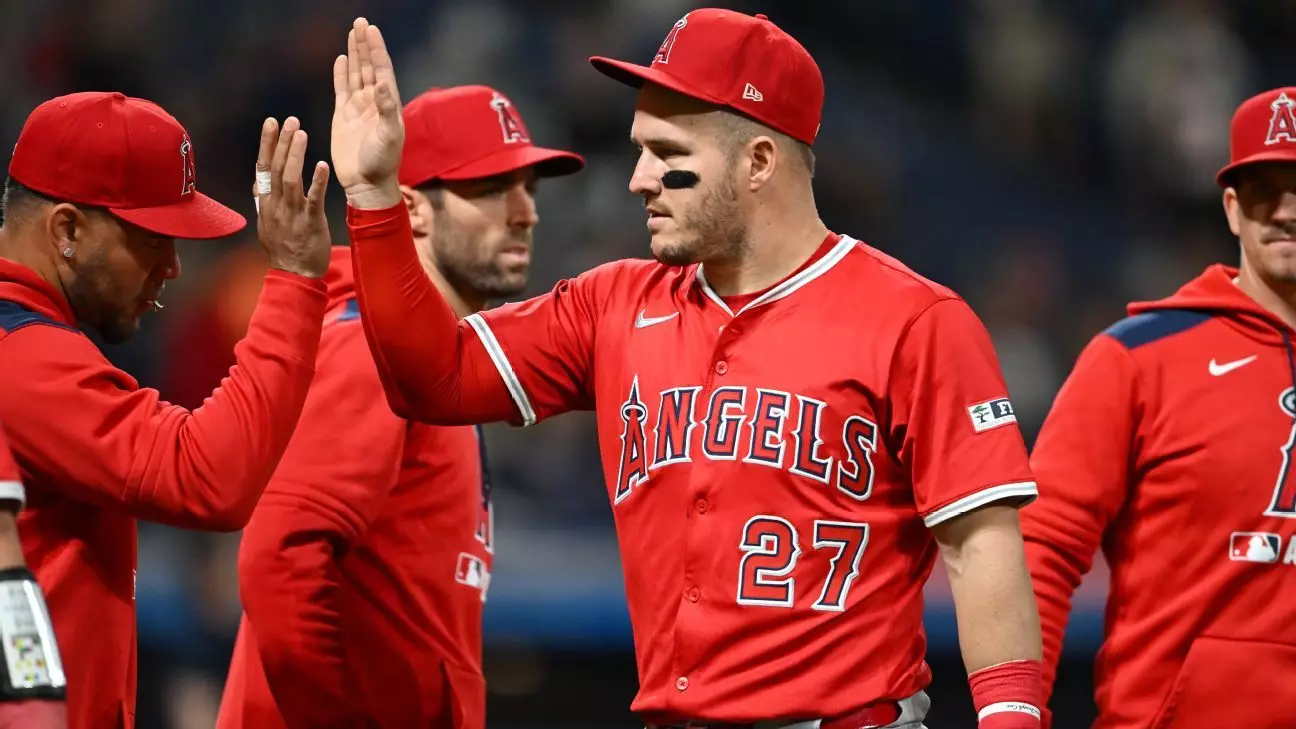The anticipation surrounding Mike Trout’s return to the Los Angeles Angels has been palpable, and for good reason. After a significant disruption due to a bone bruise in his left knee, Trout’s comeback had been eagerly awaited by fans and teammates alike, serving as a beacon of hope amid a tumultuous season. Trout’s activation off the injured list not only stirred enthusiasm within the ranks but also re-injected a dose of much-needed morale into an Angels team struggling with consistency, as evidenced by their recent five-game losing streak.
Trout’s unexpected early return to the lineup underscored the meticulous nature of rehabilitation, particularly for an athlete of his caliber who has faced a slew of injuries over the past few seasons. Originally slated to come back against the Boston Red Sox, Trout’s shift to rejoining against the Cleveland Guardians was a testament to both his determination and the team’s optimism in his recovery. Despite suffering through 26 games sidelined due to pain that originated from not just one but two prior surgeries on the same knee, Trout stepping into the batter’s box again is nothing short of remarkable.
The Impact of Mike Trout on the Team Dynamics
The Angels’ lineup without Trout felt incomplete, and his presence immediately resonated through their performance. Working as the designated hitter, Trout managed to get on base once in his first game back, demonstrating that even with restrictions, his talent and influence haven’t waned. Specifically, his single in the fourth inning showcased what the team has missed—his ability to connect solidly with the ball. It’s an undeniable fact that Trout’s return is not merely about statistics but rather the infectious energy and leadership he brings to the dugout.
Manager Ron Washington’s decision to bat Trout fifth rather than in his usual aggressive spots was strategic. Acknowledging that three full months without live pitching could necessitate a gradual re-entry into more intensive roles, Washington’s approach to protect the player adequately reflects a deeper understanding of player management and injury prevention. Trout’s assignment in the batting order allows for a safe progression back to his formidable self, preserving both his long-term health and the immediate needs of the team.
The Broader Implications of Injuries in Professional Sports
Trout’s recent injury saga provides a lens into the broader conversation surrounding injuries within professional sports. The fact that this is Trout’s fifth consecutive year experiencing a significant stint away from the field raises pertinent questions about athlete fatigue, the effectiveness of injury management, and the physical toll of high-stakes competition. Bone bruises and similar injuries can be tricky; they linger, sometimes morphing into larger problems if not handled meticulously.
As fan concern grows over Trout’s history of missed games since 2021, a pattern emerges that calls for evaluations not only of player conditioning but also team strategies surrounding player health. Trout himself acknowledged the uncertainty accompanying his current knee condition, stating explicitly, “Bone bruises are tricky. I know I am going to be sore, but I can deal with it.” This admission serves as both a note of realism and resilience—qualities that have long defined Trout’s career.
The Evolution of a Superstar
Trout’s evolution throughout his career has also been one of adapting to new roles on the team. He’s never favored the designated hitter position, yet his performance in that slot this season has showcased his versatility and commitment. With a respectable hit rate as a DH, he’s not only managing a transition in role but also rediscovering himself as a player who can contribute in various capacities. The fact that he expressed openness toward seeing how much time he’ll spend as the designated hitter this season speaks volumes about his willingness to adapt for the benefit of the team.
The prospect of returning to right field adds yet another dimension to a story filled with uncertainty and potential. The transition back to full-field play could be a crucial step for Trout, but only if managed thoughtfully. As the season progresses into more challenging matchups, understanding how to balance his health with his competitive spirit will be vital for both Trout and the Angels.
Ultimately, Mike Trout’s return is not the conclusion of an injury saga but rather a new chapter filled with possibilities—an opportunity not just for himself but also for the team that relies heavily on his prowess and leadership. In a sport where every game matters, Trout’s comeback symbolizes hope, a reminder that resilience, adaptability, and passion are often the cornerstones of success both on and off the field.

